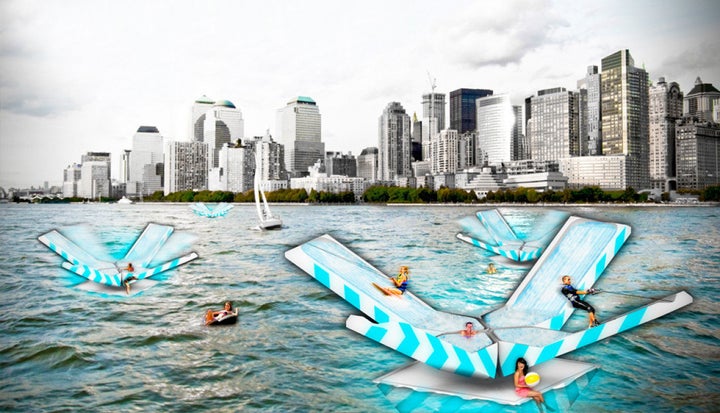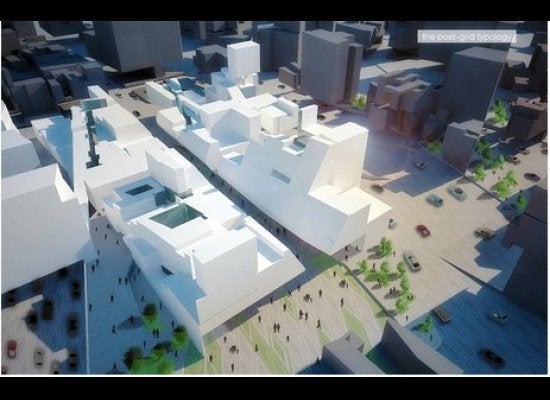
On a cloudless coffeeshop Saturday, Troy Conrad Therrien, EIM's curator, explains Experiments In Motion to me: "EIM is a year-long program initiated by Audi of America in partnership with Columbia GSAPP to at once identify new forms of urban life and their designs for New York City."
But that dry explanation hardly captures what's interesting about Experiments In Motion. The art exhibit, showing at Essex Street Warehouse at the same time as Imagining the Lowline, is an array of architectural fantasies, a technical feast. Step into the warehouse on a Saturday, and become immersed in darkness. A hanging metal sculpture projects an enormous ever-shifting map of Manhattan on the floor. The walls are lit by screens where the animation seems to swoop, showcasing fantastic New Yorks as elegant GIFs, punctuated occasionally by an explanation, architectural sketch, or 360-degree graphical rendering.
This is definitely the first time I've seen animated GIFs promoted as serious artwork, and I ask Therrien the origin of the idea. The explanation, it turns out, is surprisingly simple: before Experiments In Motion was a real world art exhibition, it was a Tumblr blog. The student-creators wanted a following, and GIFs are fodder for reblogs. So Therrien and his partner Chris Barley encouraged the students to turn their designs into GIFs. Says Therrien "The GIF takes architecture out of its unintelligible forms of representation -- plans, sections, elevations -- and reformats it in consumable ways. The trick, then, was that people who love GIFs started to consume architecture, they started to consume ideas about their city."
Certainly, the screens engage. Wandering through the screens, I see a seemingly-chaotic network of plants grown throughout the city, a series of underground rooms that spring from the streets at night, and something called "Mobile Suburbia," which proposes attachable and removable backyards for every sufficiently large apartment window.
In the space I also find Kelsey Lents, designer of Gang(Green), the proposed plant network. I manage to engage her, and ask what inspired the project, a series of wild underground gardens with plants peeking from subway grates and sewer tunnels. She brings up maps of Manhattan and how they've historically changed, from "fully unplanned meadow and marshland to a completely planned and man made grid." Her goal is to bring the green back, and do some good in the process. Via Gang(Green) "Midtown, the Lower East Side, Harlem, etc. are all interconnected" through the underground parks, which are grown in unused subway lines and sewer pipes. Manhattan, she contends, "can evolve in a direction other than by densifying architecture above ground. Once people begin to think along these lines, the potentials for the city are endless -- and I, personally, would love to see nature take back a bit of the island."
When I ask if Gang(Green) could be implemented today, her answer is surprising:
It's certainly a radical idea, but I do think given a bit of organization and research, it would be possible to grow underground parks. There is an entirely forgotten world beneath Manhattan and there is certainly already some life down there. With a little help, we could help that life thrive and create an escape from the city above. If we think of how many plant species thrive on the floors of incredibly dense forests, spreading along the ground and living on very little sunlight, what I'm proposing is an (admittedly radical) adaptation of that.
She also says that the parks, once the seeds were planted, would spread naturally and require no maintenance. Time for some guerrilla gardening?
While some of the edifices are clearly 'out there' -- Richard Phan's beautiful "Articulating The Alleyway," for instance, would require some serious city restructuring -- Therrien says that some of the ideas could be funded and built in the near future. He calls three projects 'Kickstarter-ready': Forefront, a platform for pop-up art exhibitions, Water Sparrows, an airliftable series of waterparks, and EcoDrones, a Tacocoptor-inspired seedbombing initiative that could utilize existing procedures for police drones to let seedbombers take the skies.
But even the wildest projects provide food for thought, and whimsy. At the end of our Saturday interview, Therrien talks about a project called "Lawn Printer" that he says "really stuck" with him:
It was a very straight forward but fantastic idea focused around a machine that could simply print grass. He began with the most rudimentary form, a push-cart version powered by some magical technology that was far enough in the future to be sci-fi, but somehow believable enough to be entertained. From such a simple premise, vast narratives could be told, from a contemporary resonance with a project like the Highline, to social justice tropes like the idea of the 'right to the city.' In the end, however, it's just a lawn mower in reverse.
But with the Lowline's future still uncertain, is New York City already ready for another offbeat venture? And what other cities could benefit from some inspired architecture? Tell us what you think below, and take a look at our slides of 17 projects from Experiments In Motion.
